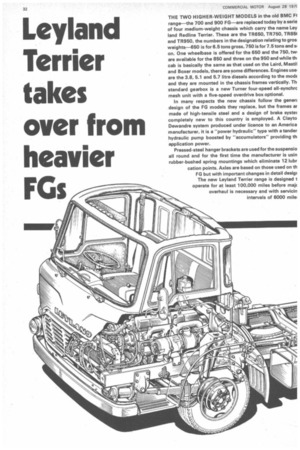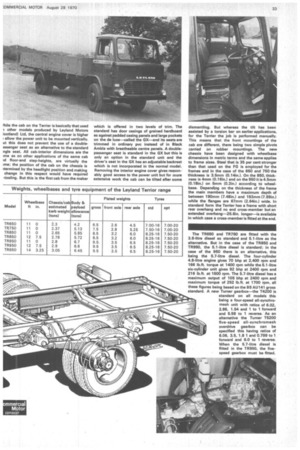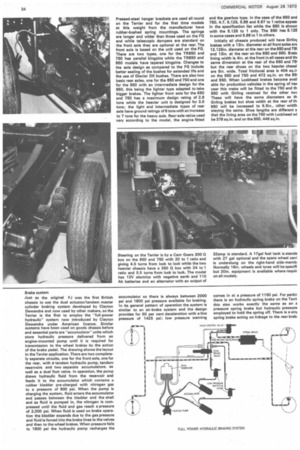Leyland Terrier takes over from heavier Ms
Page 34

Page 35

Page 36

If you've noticed an error in this article please click here to report it so we can fix it.
THE TWO HIGHER-WEIGHT MODELS in the old BMC F( range—the 700 and 900 FG—are replaced today by a eerie of four medium-weight chassis which carry the name Ley land Redline Terrier. These are the TR650, TR750, TR85( and TR950, the numbers in the designation relating to gros weights-650 is for 6.5 tons gross, 750 is for 7.5 tons and so on. One wheelbase is offered for the 650 and the 750, two are available for the 850 and three on the 950 and while till cab is basically the same as that used on the Laird, Mastil and Boxer models, there are some differences. Engines use' are the 3.8, 5.1 and 5.7 litre diesels according to the mock and they are mounted in the chassis frames vertically. Th standard gearbox is a new Turner four-speed all-synchrc mesh unit with a five-speed overdrive box optional.
In many respects the new chassis follow the genera design of the FG models they replace, but the frames ar made of high-tensile steel and a design of brake syster completely new to this country is employed. A Clayto Dewandre system produced under licence to an America manufacturer, it is a "power hydraulic" type with a tander hydraulic pump boosted by "accumulators" providing th application power.
Pressed-steel hanger brackets are used for the suspensio all round and for the first time the manufacturer is usin rubber-bushed spring mountings which eliminate 12 lubr cation points, Axles are based on those used on th FG but with important changes in detail desigr The new Leyland Terrier range is designed t operate for at least 100,000 miles before majc overhaul is necessary and with servicin intervals of 6000 mile:
Mile the cab on the Terrier is basically that used -1 other models produced by Leyland Motors lcotland) Ltd, the central engine cover is higher allow the power unit to be mounted vertically. ut this does not prevent the use of a doubleissenger seat as an alternative to the standard ngle seat. All cab-interior dimensions are the ime as on other applications of the same cab id floor-and step-heights, are virtually the ime; the position of the cab on the chassis is itermined by the headlight position and making change in this respect would have required -tooling. But this is the first cab from the maker which is offered in two levels of trim. The standard has door casings of grained hardboard as against padded casing panels and large pockets on the de luxe-called the GX-and its seats are trimmed in ordinary pvc instead of in Black Amble with breatheable centre panels. A doublepassenger seat is standard in the GX but this is only an option in the standard unit and the driver's seat in the OX has an adjustable backrest which is not incorporated in the normal model. Removing the interior engine cover gives reasonably good access to the power unit but for more extensive work the cab can be tilted after some
dismantling. But whereas the tilt has been assisted by a torsion bar on earlier applications, for the Terrier the job is performed manually. This means that the front mountings of the cab are different, there being two simple pivots carried on rubber mountings. The new chassis have been designed with wheelbase dimensions in metric terms and the same applies to frame sizes. Steel that is 36 per cent stronger than that used on the FG is employed for the frames and in the case of the 650 and 750 the thickness is 3.5mm (0.141n.). On the 860, thickness is 4mm (0.16in.) and on the 950 it is 4.5mm (0.18in.) on 5mm (0.2in.) according to wheelbase. Depending on the thickness of the frame the main members have a maximum depth of between 190mm (7.48in.) and 193mm (7.59in.) while the flanges are 67mm (2.64M.) wide. In standard form the Terrier has a frame with short rear overhang and no end cross-member but an extended overhang-25.61n. longer-is available in which case a cross-member is fitted at the end.
The TR650 and TR760 are fitted with the 3.8-litre diesel as standard and 5.1-litre as the alternative. But in the case of the TR850 and TR950, the 5.1-litre diesel is standard; in the case of the 950 there is an alternative, this being the 5.7-litre diesel. The four-cylinder 4.8-litre engine gives 70 bhp at 2,400 rpm and 166 lb.ft. torque at 1400 rpm while the 5.1-litre six-cylinder unit gives 92 bhp at 2400 rpm and 216 lb.ft, at 1500 rpm. The 6.7-litre diesel has a maximum output of 105 bhp at 2400 rpm and maximum torque of 252 lb.ft. at 1700 rpm, all these figures being based on the BS AU141 gross standard. A new Turner gearbox-the T4200 is standard on all models this being a four-speed all-synchromesh unit with ratios of 6.02, 2.86, 1.54 and 1 to 1 forward and 5.58 to 1 reverse. As an alternative the Turner T5200 five-speed all-synchromesh overdrive gearbox can be specified this having ratios of 6.06, 3.5, 1.8 1 and 0.799 to 1 forward and 6.0 to 1 reverse. When the 5.7-litre diesel is fitted in the TR950, the fivespeed gearbox must be fitted.
Pressed-steel hanger brackets are used all round on the Terrier and for the first time models at this weight from the manufacturer have rubber-bushed spring mountings. The springs are longer and wider than those used on the FG and while telescopic dampers are standard on the front axle they ere optional at the rear. The front axle is based on the unit used on the FO. There are two types, one for the TR650 and 750 has parallel kingpins while the TR850 and 950 models have tapered kingpins. Changes to the axle design as compared to the FO include better sealing of the bushes for extended life and the use of Glacier DX bushes. There are also two basic rear axles, one for the 660 and 750 and one for the 950 with an intermediate design for the 860, this being the lighter type adapted to take bigger brakes. The lighter front axle for the 650 and 760 has a maximum design rating of 2.8 tons while the heavier unit is designed for 3.5 tons; the light and intermediate types of rear axle have ground ratings of 6 tons with an increase to 7 tons for the heavy axle. Rear axle ratios used vary according to the model, the engine fitted Steering on the Terrier is by a Cam Gears 300 Q box on the 650 and 750 with 20 to 1 ratio and giving 4.5 turns from lock to lock while the two heavier chassis have a 350 Q box with 24 to 1 ratio and 5.5 turns from lock to lock. The modal has 12V electrics with negative earth and 110 Ah batteries and an alternator with an output of end the gearbox type. In the case of the 660 and 750, 4.7, 5.125, 5.86 end 6.67 to 1 ratios appear In the specification list while the 850 is shown with the 6.126 to 1 only. The 950 has 5.126 in some cases and 5.86 to 1 In others.
Initially all chassis produced will have Girlint brakes with a 131n. diameter et all front axles anc 12.125in. diameter at the rear an the 660 and 76( and 131n, at the rear on the 850 and 960. Braid lining width is 41n. at the front in all cases and th■ same dimension at the rear of the 650 and 751 but the rear shoes on the two heavier chess' are Sin. wide. Total frictional area Is 4.04 sq.ir on the 650 and 750 and 472 sq.in. on the 851 and 960. When Lockheed brakes become avail able for production vehicles in the spring of mei year this make will be fitted to the 750 and th 950 with Girling retained for the other twc These will have the same diameters as th Girling brakes but shoe width at the rear of th 950 will be increased to 5.5in., other width staying the same. Shoe lengths are different that the lining area on the 750 with Lockheed wi be 378 sq.in. and on the 960.446 sq.in.
32amp is standard. A 17gal fuel tank is standa with 27 gal optional and the spare wheel carri is underslung on the right-hand side-membi Normally 16in. wheels and tyres will be specifi but 20m. equipment is available where requir on all models.
Brake system
Just as the original FJ was the first British chassis to use the dual actuator/tandem master cylinder braking system developed by Clayton Dewandre and now used by other makers, so the Terrier is the first to employ the "full-power hydraulic" system now .introduced by Clayton Dewandre under American licence. Similar systems have been used on goods chassis before and essential parts are "accumulator" units which store hydraulic pressure delivered from an engine-mounted pump until it is required for transmission to the wheel brakes by the action of the brake pedal. The drawing shows the layout in the Terrier application. There are two completely separate circuits, one for the front axle, one for the rear, with a tandem hydraulic pump, tandem reservoirs and two separate accumulators, as well as a dual foot valve. In operation, the pump draws hydraulic fluid from the reservoir and feeds it to the accumulator which contains a rubber bladder pre-charged with nitrogen gas to a pressure of 800 psi. When the pump is charging the system, fluid enters the accumulator and passes between the bladder and the shell and as fluid is pumped in, the nitrogen is compressed until the fluid and gas reach a pressure of 2,000 psi. When fluid is used on brake operation the bladder expands due to the gas pressure and fluid is forced into the brake lines to the valves and then to the wheel brakes. When pressure falls to 1800 psi the hydraulic pump recharges the
accumulator so there is always between 2000 psi and 1800 psi pressure available for braking. In its general pattern of operation the system is similar to an air-brake system and the design provides for 60 per cent deceleration with a line pressure of 1425 psi; low pressure warning
comes in at a pressure of 1160 psi. For parlcir there is an hydraulic spring brake on the Terri this also works exactly the same as an a pressure spring brake but hydraulic pressure employed to hold the spring off. There is a sini spring brake acting on linkage to the rear bralo
































































































